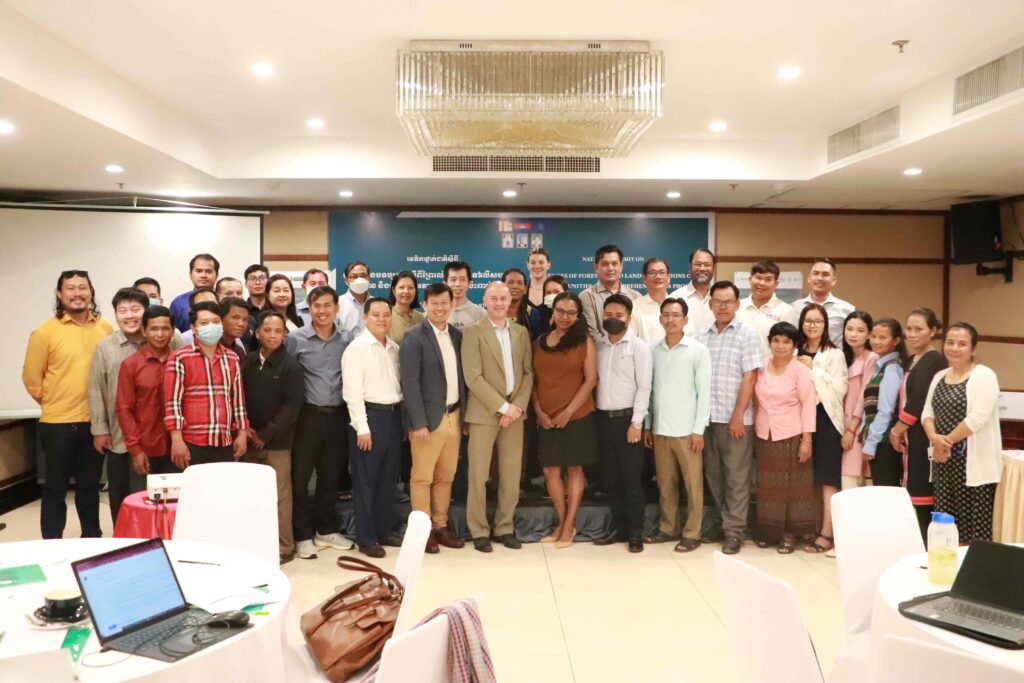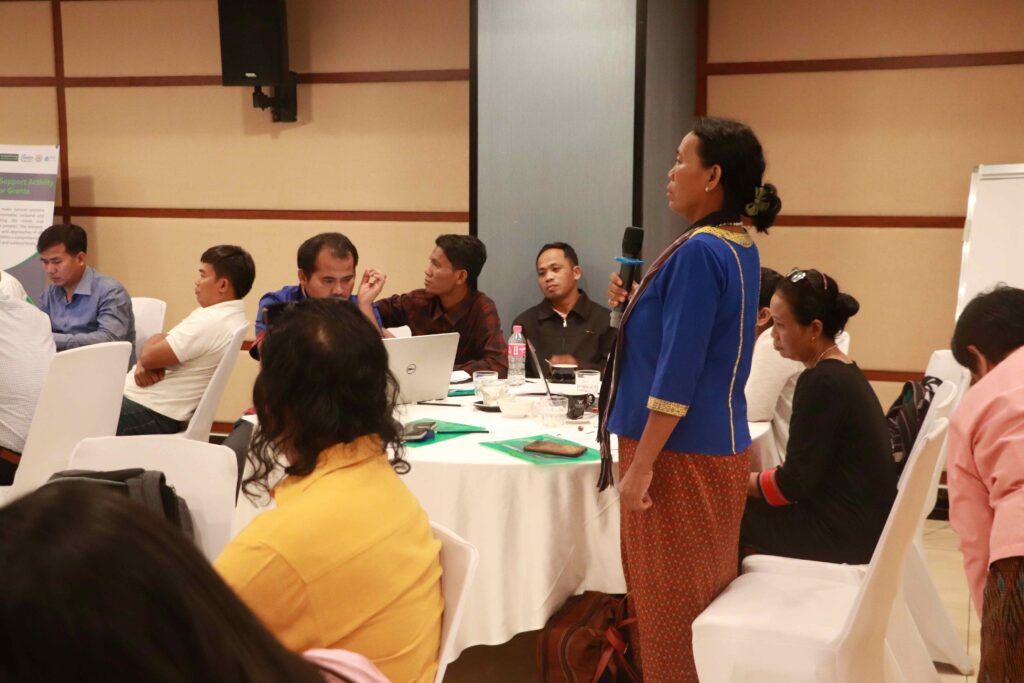National summit on influences of forestry and land regulations on local communities and comprehensive EIA process
Open Development Cambodia (ODC) organized a national summit on “Influences of Forestry and Land Regulations on Local Communities and Comprehensive EIA Process” on 25 May 2023 with a total of 43 (13 females) representatives from the Ministry of Rural Development (MRD), CSOs, EIA firm, journalists, and indigenous peoples from Ratanakiri, Mondulkiri, Kratie, Pursat, Stung Treng, Preah Vihear, and Kampong Thom provinces. The event was supported by the United States Agency for International Development (USAID) through Family Health International (FHI 360) under the Civil Society Support Activity: Cluster Anchor Grants, and Heinrich Böll Stiftung Cambodia (HBS) under the project of promoting EIA for more transparent and responsive environmental governance in Cambodia.
The national summit aims to:
- Provide an opportunity for relevant stakeholders to express their concerns regarding existing and proposed forestry and land law and associated regulations
- Identify the effective strategy to provide input into the draft laws
- Discuss how the proposed law and associated regulations will interact with the EIA process, particularly the engagement of local communities and the public more broadly.
The team invited Mr. IL Oeur, Executive Director of Analyzing Development Issues Centre (ADIC), and Ms. YA Yanny, a representative of indigenous women from Mondulkiri province to be the speakers. Mr. THY Try, Executive Director of ODC was the moderator of the panel discussion on “Forestry and land regulations”. The discussion started by introducing the speakers as well as their work. Analyzing Development Issues Centre (ADIC) shared their research on public participation in Prey Preah Roka Wildlife Sanctuary and Chhaeb district, Preah Vihear province. The Ministry of Environment (MoE) had clear guidelines and engaged the local community in the process. They set up numerous local and national meetings for two years to map the areas. This is the first map that engages many people, so there are no concerns raised by the local community during the mapping process. The concern is that when the map is released, who will be responsible for border demarcation? The land inventory is also significant to identify the specific land that each indigenous people own within the communal land title.
Then questions were raised around the differences in duration of the indigenous communal land titling and private land title as well as the word usage in the law. A representative from the Cambodia Indigenous Peoples Organization (CIPO) shared the concern on the indigenous community cannot do the rotation or traditional agriculture unless they have been registered. That’s a critical point if the community grows the crop or rice on the land. A response from the MRD, if the community has been recognized as an indigenous group by the ministry, there should not be a problem to use the land. The representative from CIPO also mentioned the concern about excluding the word “Indigenous peoples” in the draft law. Indigenous peoples would like to keep their identity (differentiate from other people) both in the current and upcoming laws. Regarding the input, we would like to see a separate chapter talking about the indigenous people within the Land Law. The discussion between the CSOs and indigenous peoples should be happened before meeting with the related ministries to share their concerns to address in the draft law. The discussion around the reasons for revising or amending the law should be widely disseminated. The government should open for consultation with practical and concerned stakeholders.
A representative from 3SPN stated that the draft EIA law excludes the word “FPIC” meaning free, prior, and informed consent. The law encourages to have full public participation in all areas. Fully participation has a different definition from FPIC which considered accessing the information, participation, and decision-making. The participants highlighted that cooperation and working together among key CSOs is very important. By doing so, we could enforce and coordinate the mechanism and inputs effectively.
There is an interesting question from the private company regarding indigenous peoples’ economic, livelihood, and materials trends. The question has attacked the attention of indigenous peoples in the rooms to share where they are now.
They said, “Some people get a larger house and modern materials, but some of them have to pay back the loan every month. Some people are poor and do not even have a small area of land to grow crops. What we are now cannot be compared with what we have lost. Although we need to adapt to the modern era, we would not want to lose what we used to have, especially the culture.“
In brief, we discussed the inputs which also reflect several significant points including cooperation among key stakeholders and CSOs in the input gathering and providing to the policy-makers as well as networking with the related ministries, case studies in Mondulkiri, Ratanakiri, and Preah Vihear, and the word usage in the law.
The panel discussion on “EIA process: Public participation” brought together Mr. HORM Kimkong, Director of Environmental and Assessment (E&A) Consultancy, Mrs. TEP Tim, a representative of indigenous women from Preah Vihear province, Mr. LEANG Bunleap, Executive Director of 3S Rivers Protection Network (3SPN). The discussion was moderated by Mr. LONN Pichdara, Executive Director of MyVillage Cambodia.
Mrs. TEP Tim living in Prame commune, Tbaeng Mean Chey district, Preah Vihear province, said that she did not get an invitation to join the public participation of the EIA process as well informed about the development project beforehand. So far, they only invited the commune and district councils to the meeting. A representative from 3SPN stated that public participation sometimes could provide the opportunity for the company to only gather the people who agree and support the project. The law or regulation on public participation is very important, and it should clearly state who should be invited to join such as from the beginning of the process.
“When we are discussing the Land Law, it should also refer to the Cambodian people as well. Why the discussion this morning was focusing on indigenous peoples only?” Question from our participant.
Yes, it should be referring to everyone. However, we would like to pay more attention to the indigenous peoples because they are the most vulnerable group among others. From time to time, they live and survive in the forest and do not have any land titles as we do. When there is a development project, they always eye on the forest areas where there are not many people living there.
In the case of Cambodia, some projects just process the EIA after a long-term operation. The participants wonder what is the point behind that. EIA is just a tool to assess the impact, not a law. There are three types of EIA implementation including EIA before, during, and after the project implementations. The companies that were established a long time ago do not have EIA since it did not exist at that time. As a result, the MoE review and request them to do the EIA. The new development projects currently must have done the EIA before implementing the project based on the guideline of the ministry.
EIA report is very difficult to get. How could we get the EIA reports? Normally, when the report is approved, the consultant, project owner, and the MoE have to stamp each page of the report. Previously, the consultant has to prepare 12 copies, but currently, there are only six copies required which will be kept by the consultant (1), the project owner (1), and the rest will be kept by the EIA Department. The consultant needs to keep the report in a safe place for 3 or 5 years based on the agreement, and they cannot share the report without permission from the project owner. The report could be officially requested from the MoE. Our speakers also suggested the community and CSOs keep all the related documents they provided during public participation. The discussion and content of the provided documents will not have much difference from the approved EIA report. Additionally, the stakeholders should focus on the EIA training for the local community so that they could understand the process as well as the content of the report.






